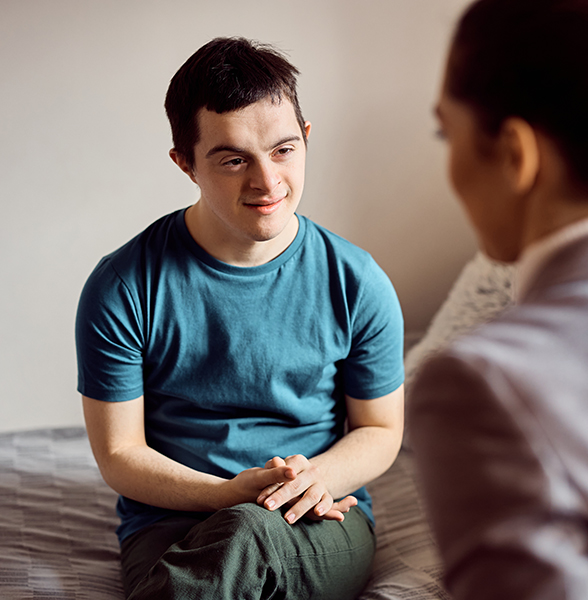There are a lot of ways in which the time shortly after an epilepsy diagnosis can leave you feeling a bit lost. It can cast a threatening shadow of uncertainty over your plans and hopes for the future and leave you with more questions than answers. Luckily, organisations like Epilepsy Action are there so you can speak to someone who understands, and can get some answers and support to get things back on track.
But the worries that surround a diagnosis are not the only way you can be plunged into darkness by epilepsy…
Jo is 49, lives in Bradford, and has had epilepsy since around the age of 22. She has tonic-clonic, atonic and focal seizures, and has them in the daytime and during sleep. She currently takes clobazam, which she has had for a few years, and Tegretol (carbamazepine), which she has had for around 20 years. Despite trying many epilepsy medicines, Jo’s seizures have been uncontrolled since she first started having them.
“As far as I know, my first seizure was around a week after the sudden loss of a close friend called Joe, who died in a tragic accident. He was only 20 and this was a huge shock for us all.”
Doctors told Jo they thought the shock of losing her friend had caused her seizures. She started keeping diaries of her seizures from then on. They were fewer, but more severe and harder to recover from mentally and physically than her seizures today.
Before being diagnosed, her only experience of epilepsy was a friend from school who had tonic-clonic seizures, which seemed like the ‘norm’ for someone having epilepsy to her at the time. “I didn’t know about the many other types of seizures people could have and there was no history of epilepsy in my family,” she explained.
Jo added that she was told “nothing at all really” about the way epilepsy might impact her day-to-day life. She said her mum was the one who managed to get more information as she was “used to extracting information from GPs and consultants”.
Among the many things about epilepsy Jo wasn’t told about were the possible harmful effects of Epilim – also known as sodium valproate – if taken during pregnancy. This medicine is an important epilepsy treatment, which may be the most effective to control seizures in some people. However, if taken in pregnancy, it can cause physical and developmental problems in babies.
“I was prescribed Epilim as my first medication. For years, women were often not told about the risks of taking sodium valproate and there has been a long-standing battle to make sure women are made aware of them when they are prescribed this medicine. Prescription guidelines now state women have to sign a form when they are prescribed sodium valproate to confirm they’ve been made aware of the risks. Like most women at the time, I wasn’t told anything about these risks at all. I found out after I’d become pregnant, but I was on a different medicine by then. Luckily, my daughter Meg was born with none of the problems that some epilepsy medicines can cause.
“Also, there was no information at the beginning about the long-term effects of other medicines such as my current one, carbamazepine. This can cause bone problems, such as osteoporosis, after using it for a long time. When I became aware of this, I asked for blood tests to check my vitamin D levels. The results were low, so I take vitamin D daily and my levels are normal now.”
But, for Jo, one of the most significant effects of epilepsy emerged at the age of 24.
Filling in the gaps
One day, Jo woke up from a seizure in a strange room. A woman she didn’t recognise was sitting next to her. She introduced herself as her mum, Carol. Downstairs, two more unfamiliar faces told her that they are her stepdad Charlie and her brother Sam. Jo didn’t recognise the house she was in or even her own name on a college folder in her bedroom.
Jo’s mum took her to the doctor, who said that he expected this was a short-term side-effect of her epilepsy medicines. Weeks and months went past, but Jo’s memories were gone. She would look at old photos from childhood, but nothing jogged her memory.
“I don’t remember things like my school days or my dad’s wedding in my early twenties” she said.
Jo kept her teenage diaries and any letters she’d been sent by friends for years, which helped her fill in the gaps. “I’m so pleased I kept them!” she reflected. She found many letters to and from her friend Joe – and she realised then that he and his death were vague but important memories that she still had. But to this day, most of Jo’s early memories haven’t come back.
“A few years ago I had a look through my photos and diaries again with my best friend Nikki. We’ve been best mates since our early teens and still are to this day. Because you tend to forget a bit more as you get older anyway, she was also surprised to be reminded of some of the things we did. But she also confirmed to me people we knew and places we went.
“To explain it simply, it feels like the first 20 or so years of my life are like a film I’ve watched many times and know the scenes well, but it doesn’t feel like that person is the person I’ve known since then. I just have to trust and believe what I’ve been told. Photos, videos and letters prove things to be correct, but this doesn’t feel like it was my own childhood or young adulthood.”
Jo explains that her memory is still not good to this day – a common problem for many people with epilepsy – but she has developed coping strategies. “I have my own systems for running our business – I use reminders, the notes app on my phone, and I take lots of photos and videos of various things. I ensure that I keep these files in named folders and they are backed up.
“My daughter, who is 22 now, seems to remember everything and reminds me of things when needed!
“To this day, I still get told about things that happened when I was younger. This is from close friends who have known me since I was a teenager and before my first seizure. I have incredible support from my husband, daughter and close friends – I wouldn’t cope without this. We feel it is important to have a sense of humour about it all as much as possible. We manage to make jokes and it breaks the ice both at home and in the outside world.”
Purple Day
To mark Purple Day, Epilepsy Action has released a new, minute-long video to give viewers a glimpse into what it can feel like to be diagnosed with epilepsy.
Jo was asked to come to the filming of the video and take part. She shares some glimpses from behind the curtain.
“I was more than happy to be contacted as a media volunteer to help with the Purple Day video. I wasn’t told much about the project at all, except that I would be asked to hold a mobile phone and wouldn’t need to speak.
“When I arrived I was fascinated by how everything was set up – especially the many large lightbulbs that were hanging from long cables and the use of the lighting diffusers above our heads.
“Once I realised what the video was representing and how it was being produced, everything made sense. We’d already had a few retakes before I heard the pre-recorded audio for the first time. It was quite emotional to hear this the first few times – I actually felt goosebumps. The way it was produced was really powerful.
“There was incredible attention to every single detail. This would range from a few hairs being out of place on the main character (gelled down between takes!) to getting the speed of the camera rolling and its zoom at particular times just right.
“I was impressed by the set up and how people worked together to get things right. I didn’t really feel like an extra, but rather a part of a professional team. I thought there would be quite a few volunteers taking part in the film, so I was surprised to find out I was the only one when I arrived. Everyone else was a professional (film crew, make-up, extras) and staff from Epilepsy Action.”
You can find out more about Purple Day this year, or donate, on the Epilepsy Action website.
Listen to EpilepsyCast
Regular audio updates from the people leading the conversation around epilepsy.
More articles



Want more articles like this?
Become a member today and receive Epilepsy Today packed with further information.




